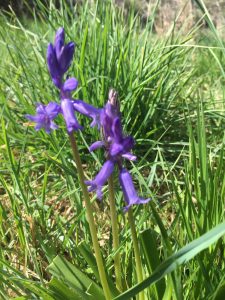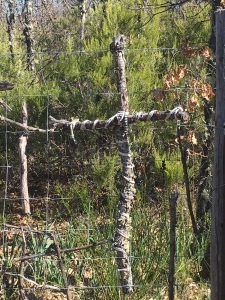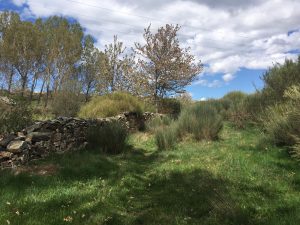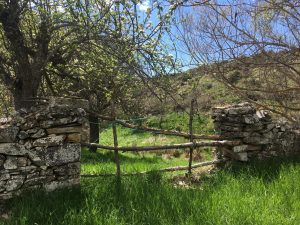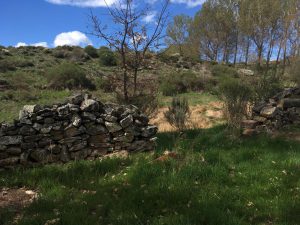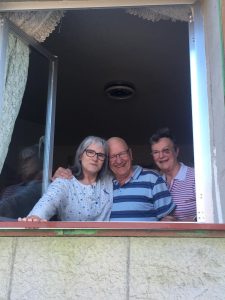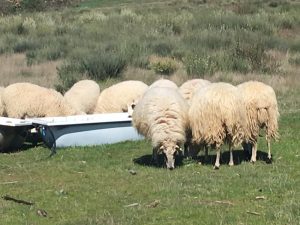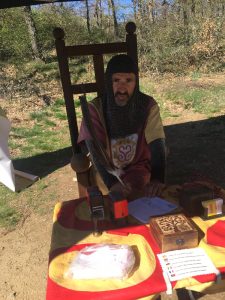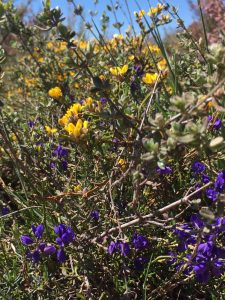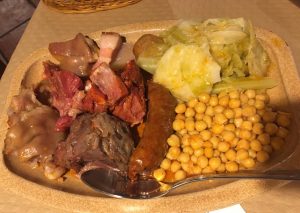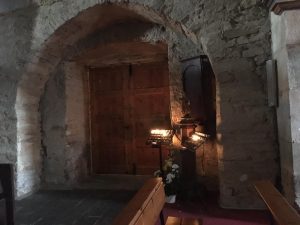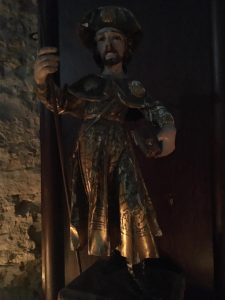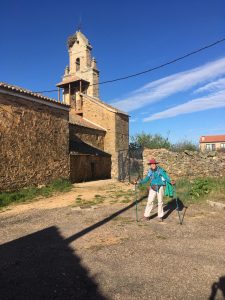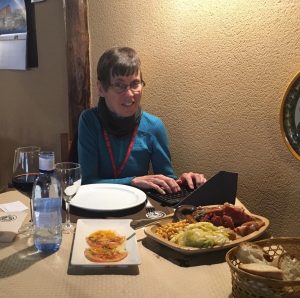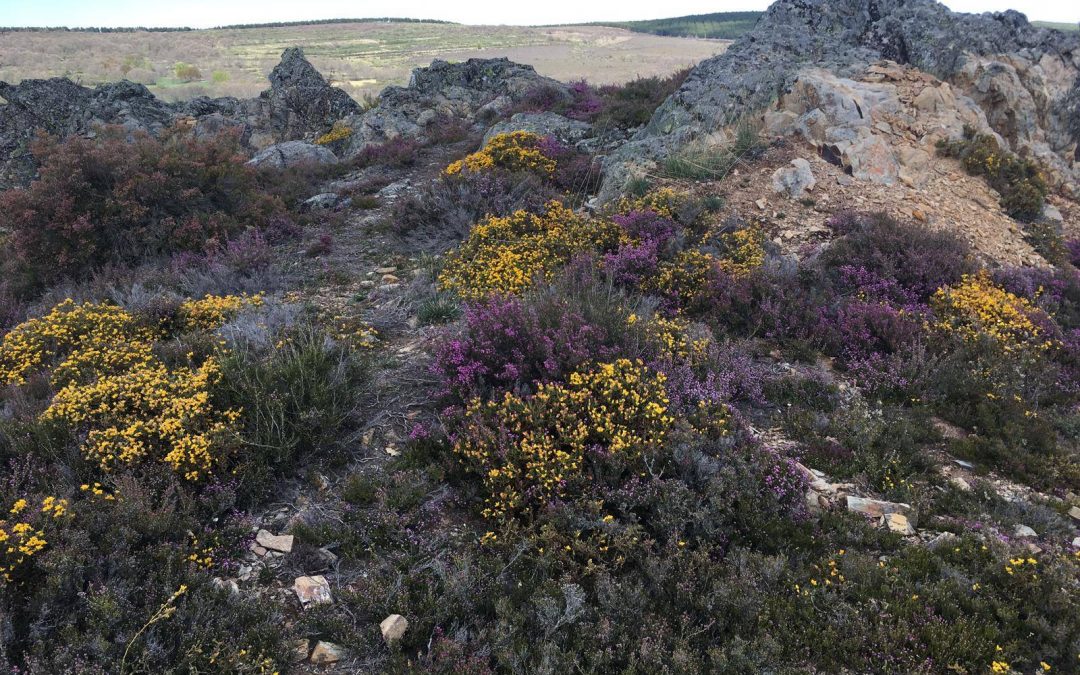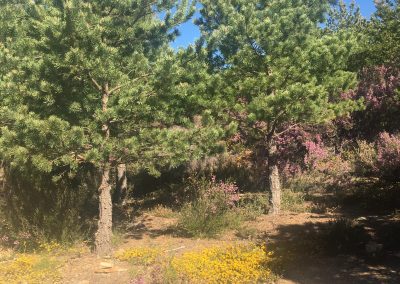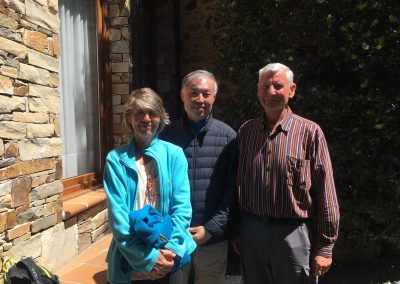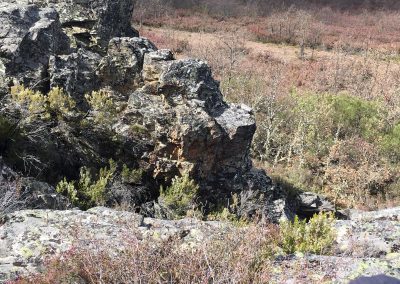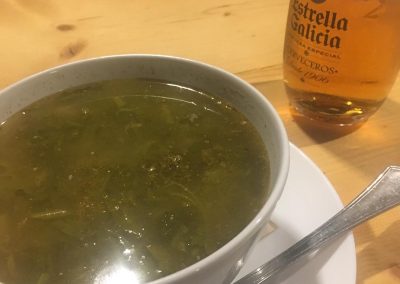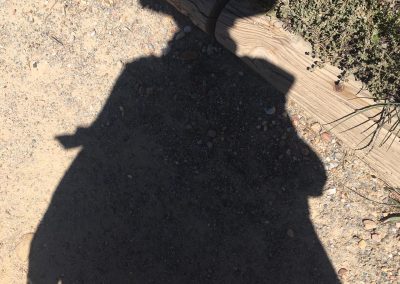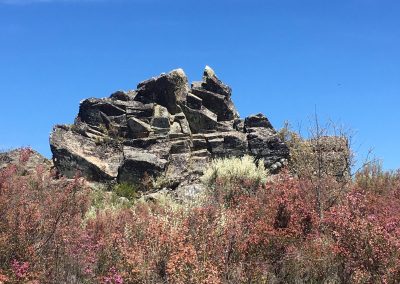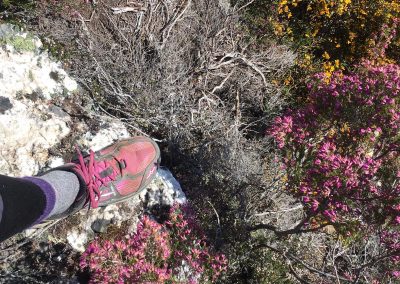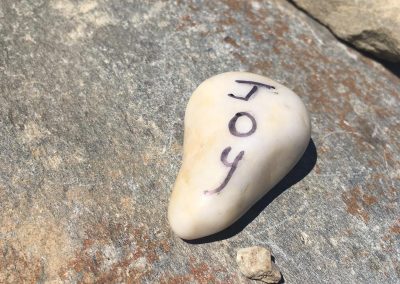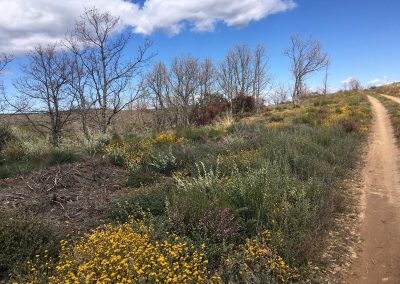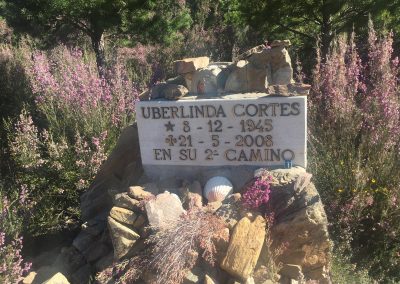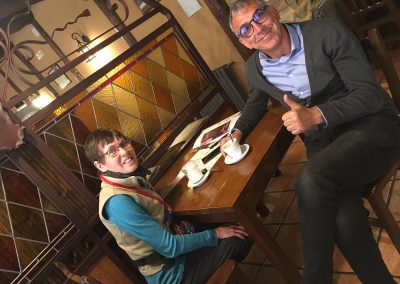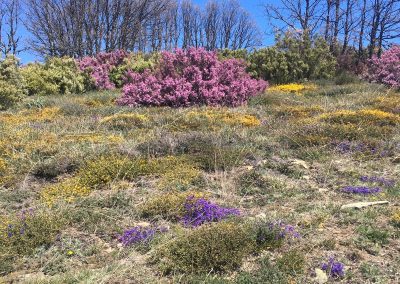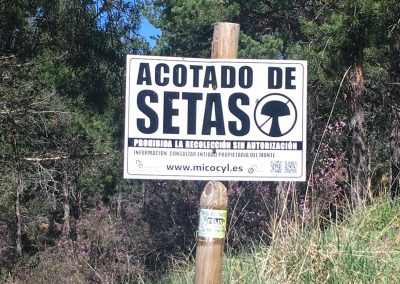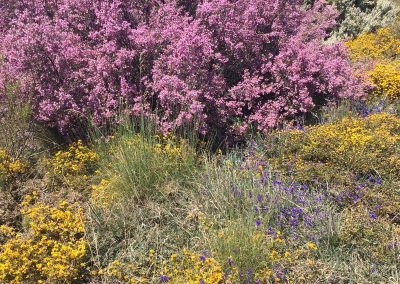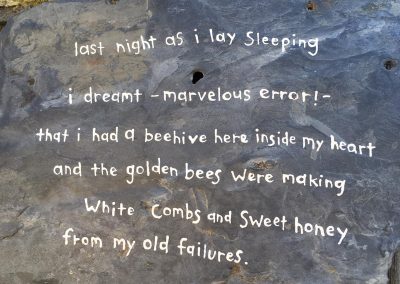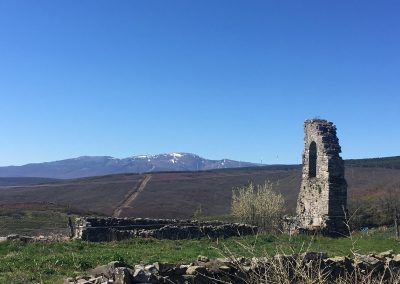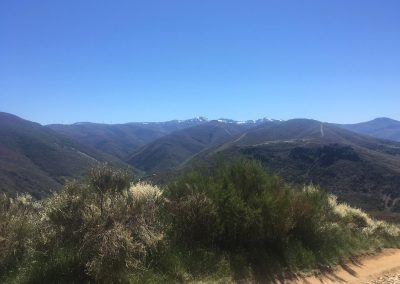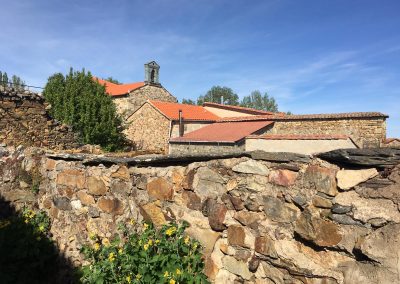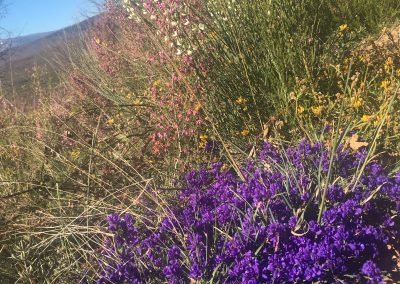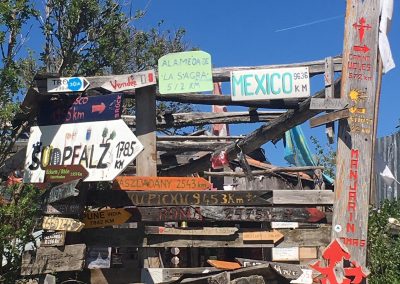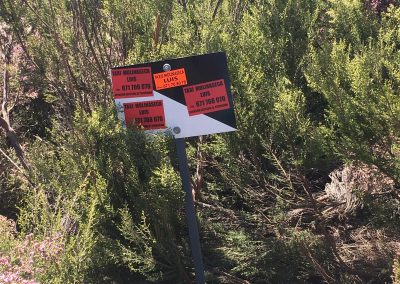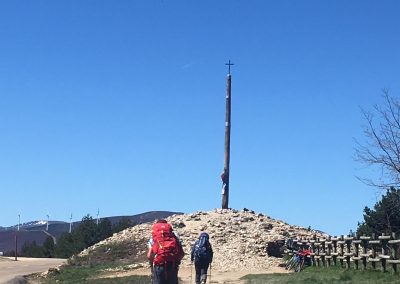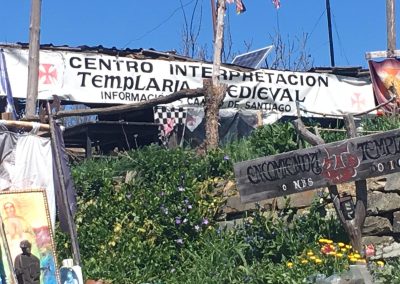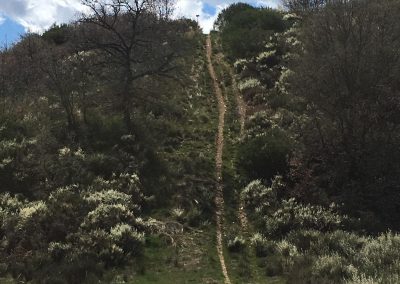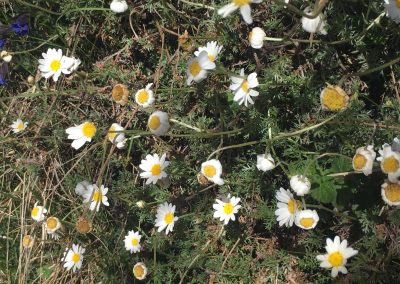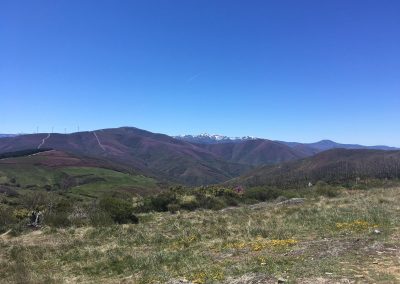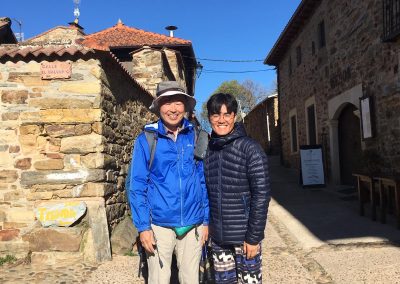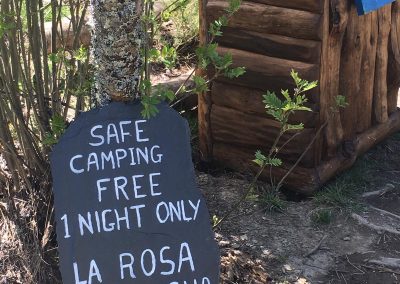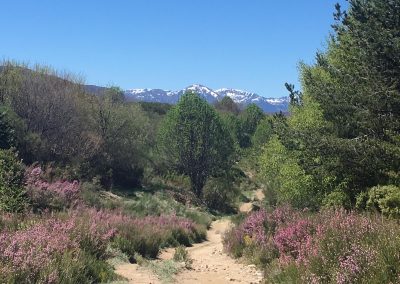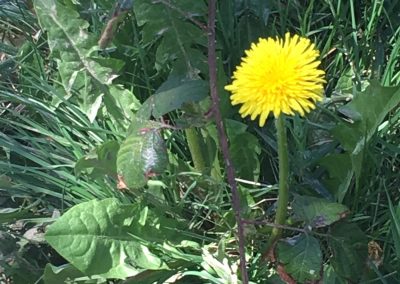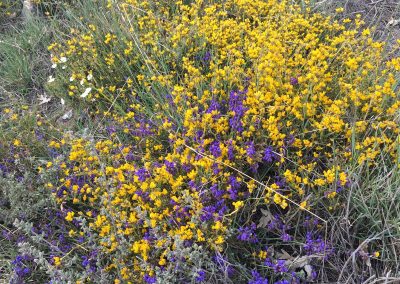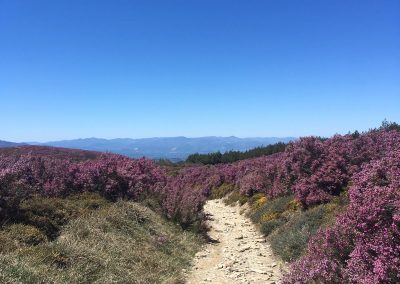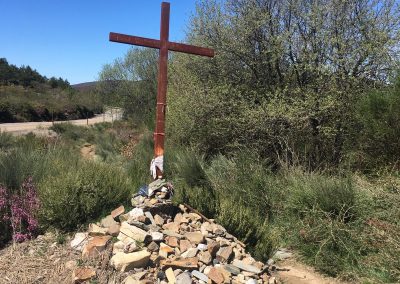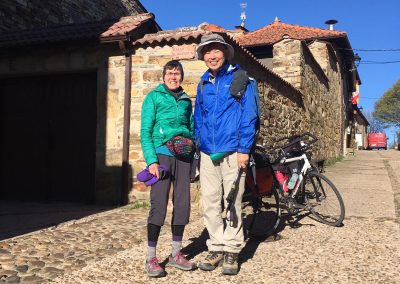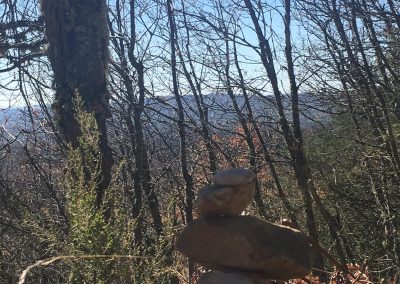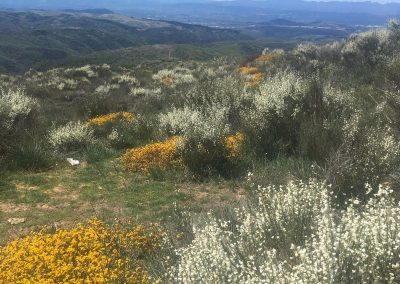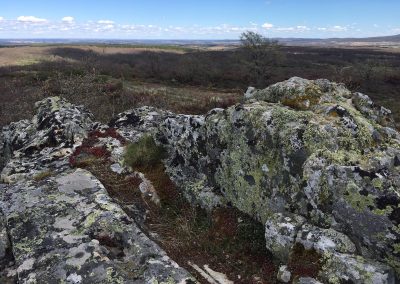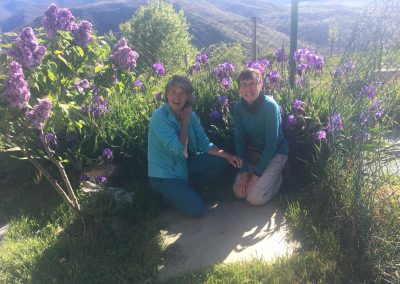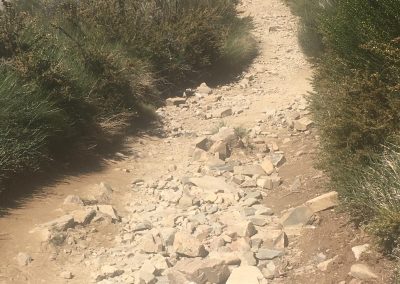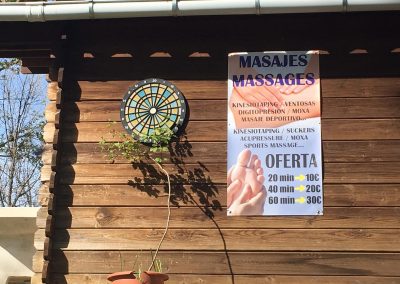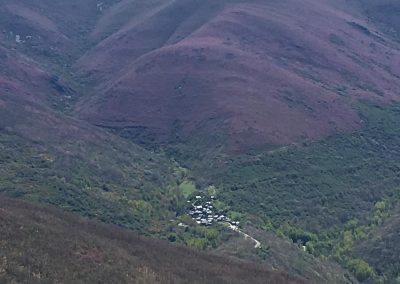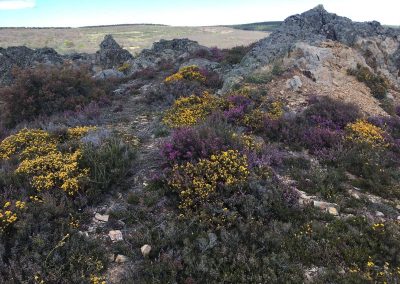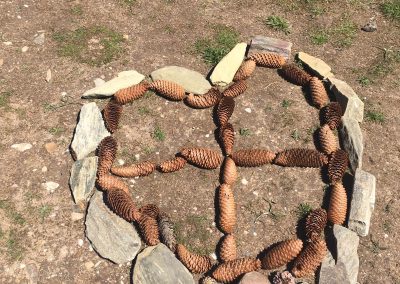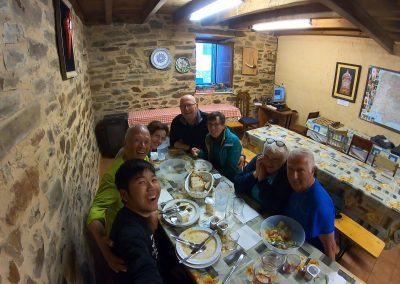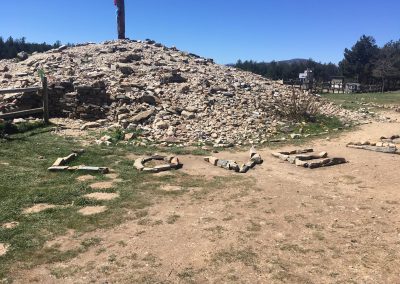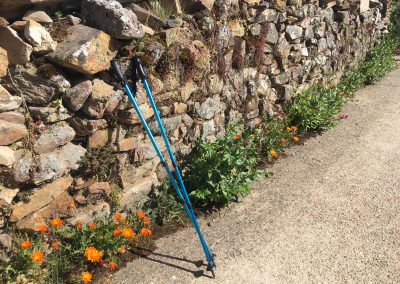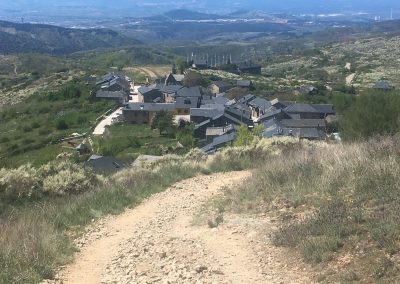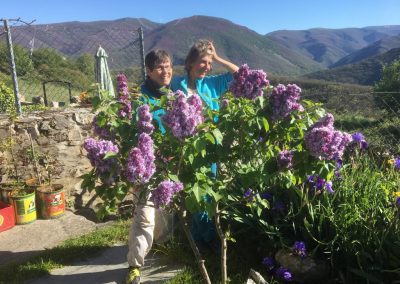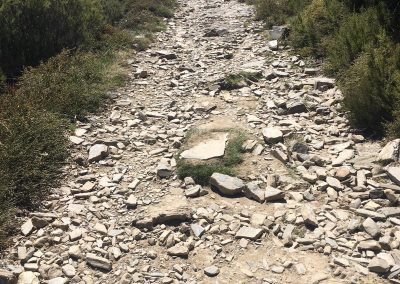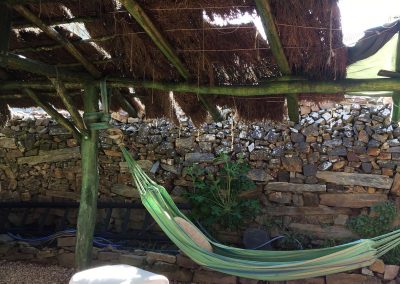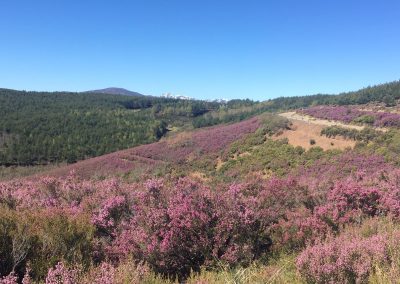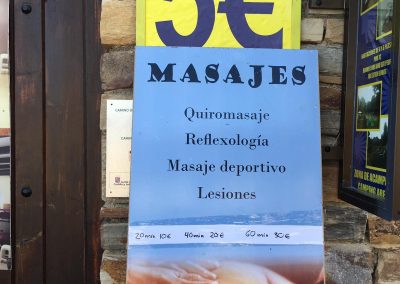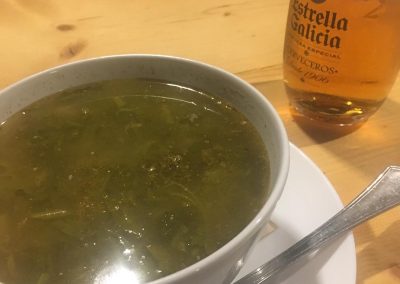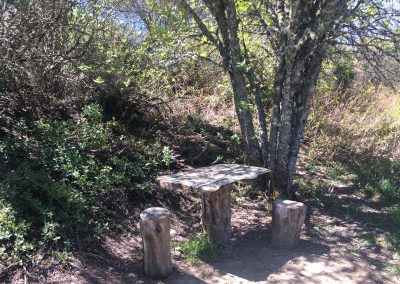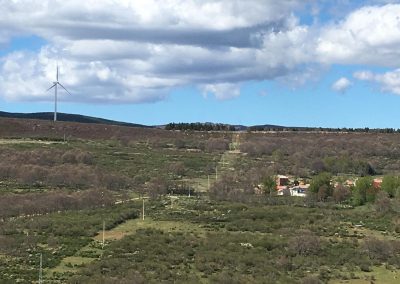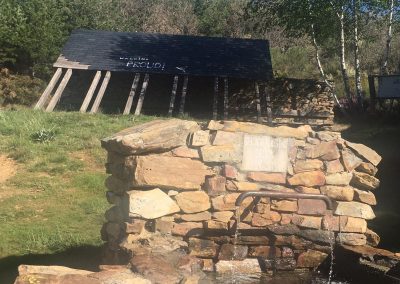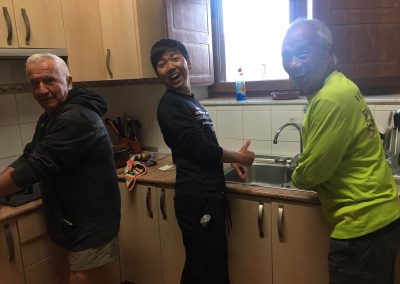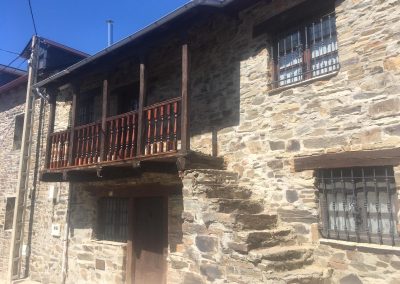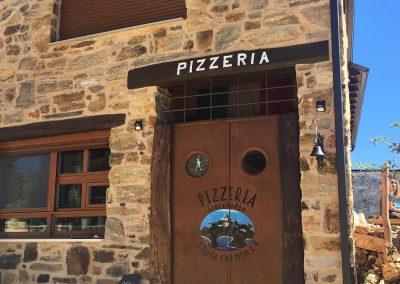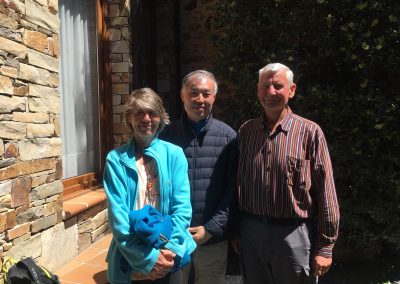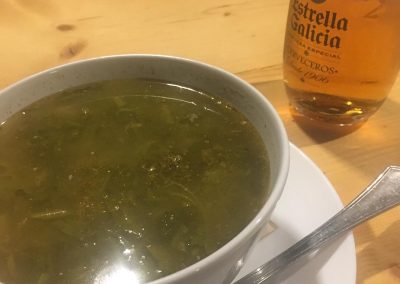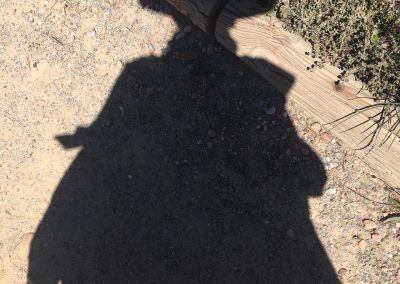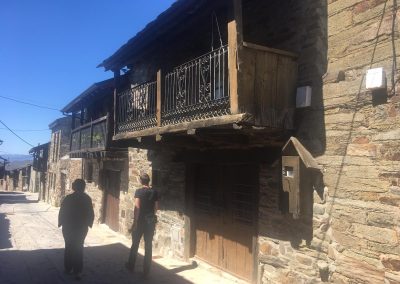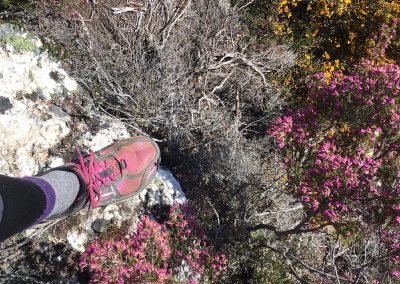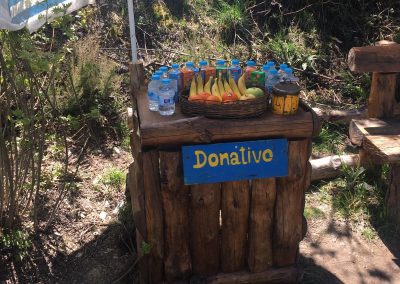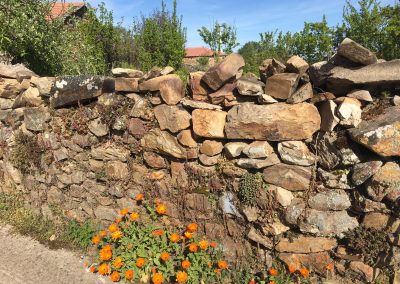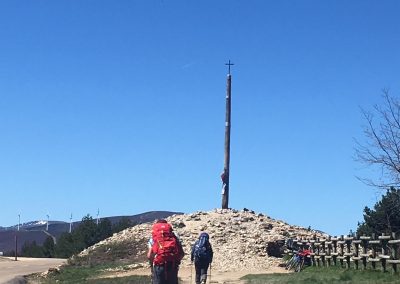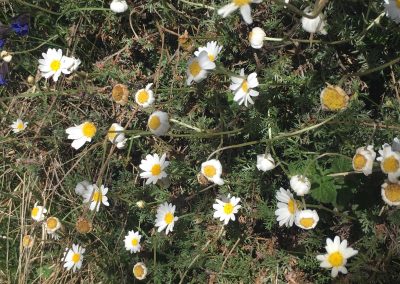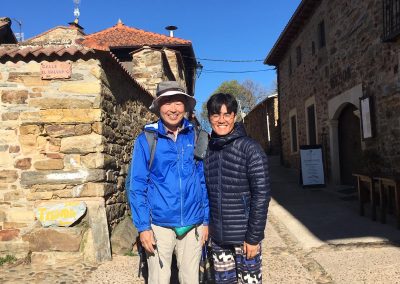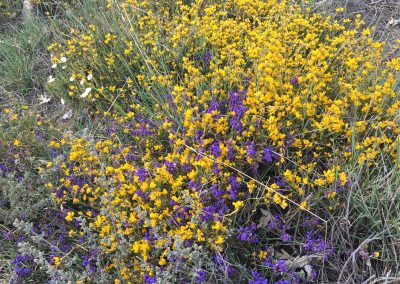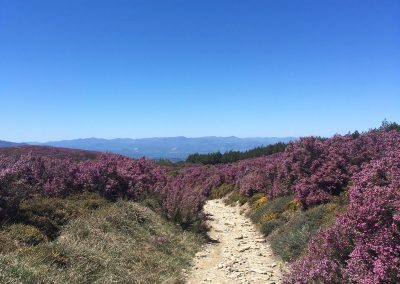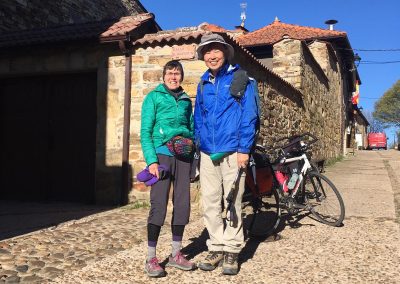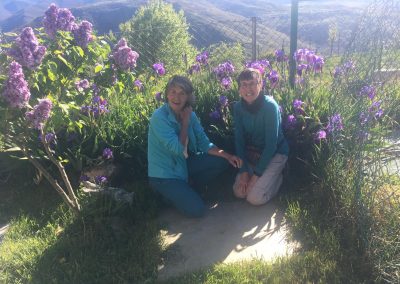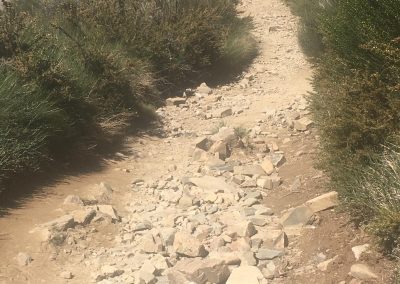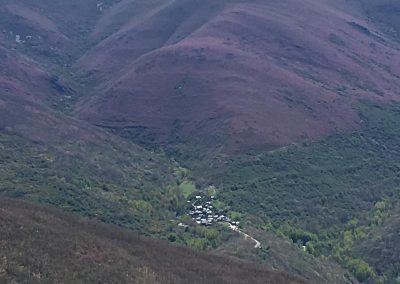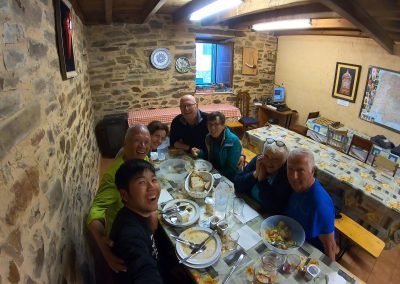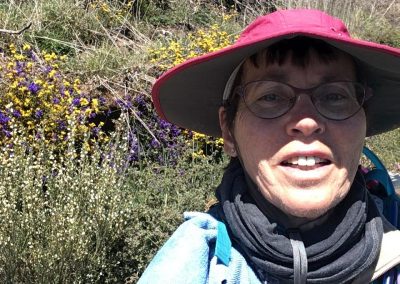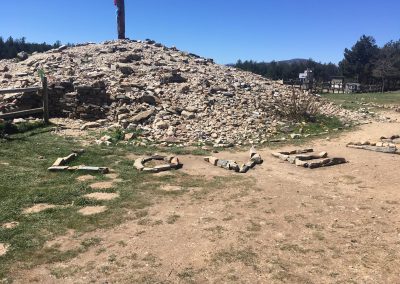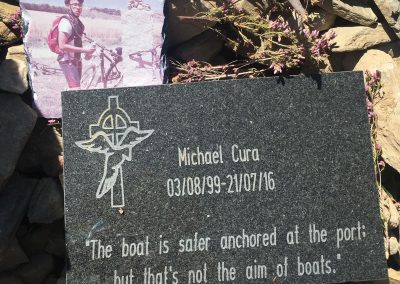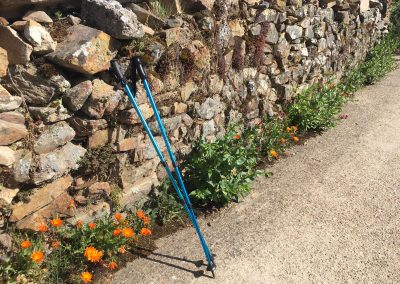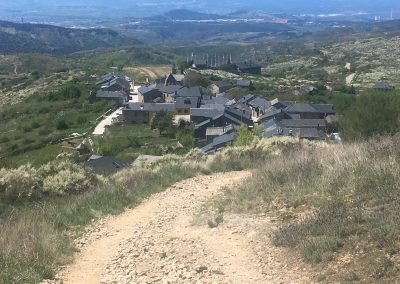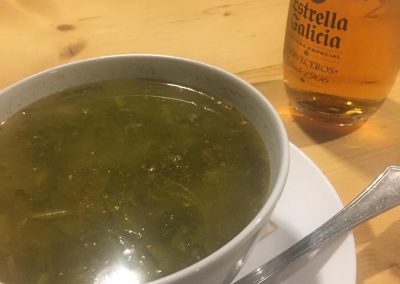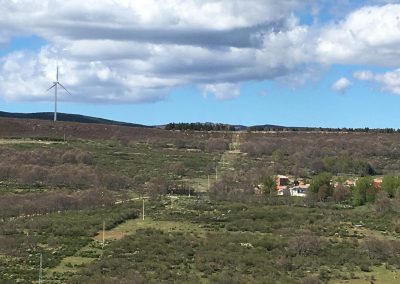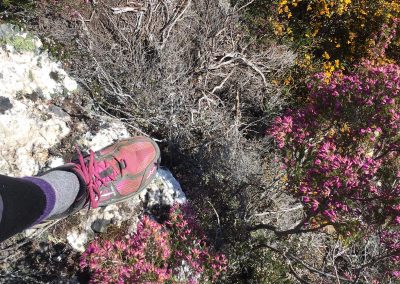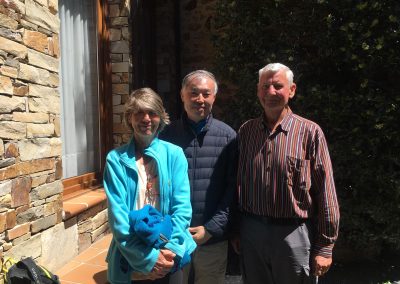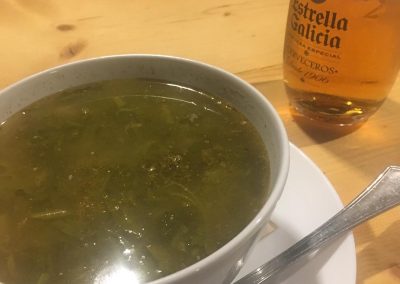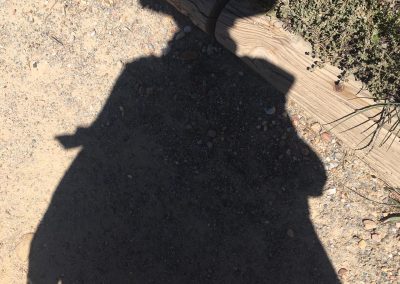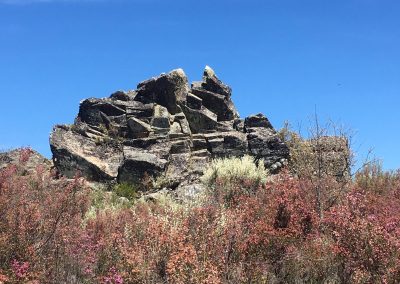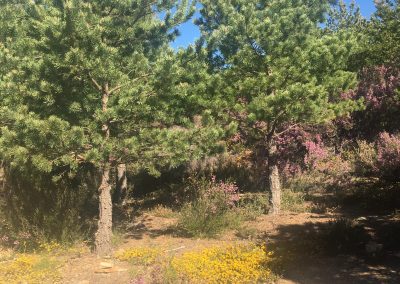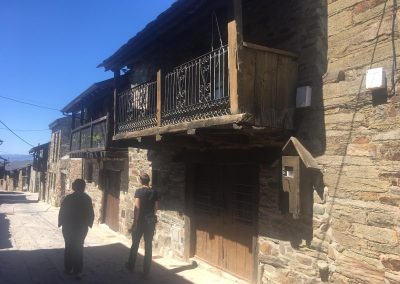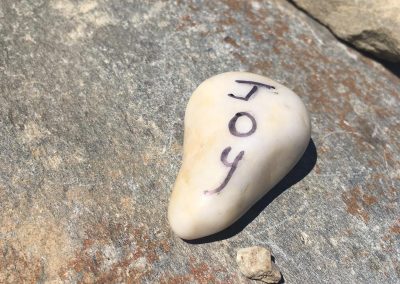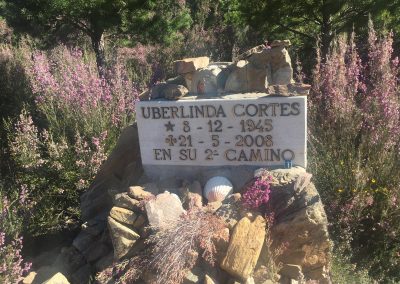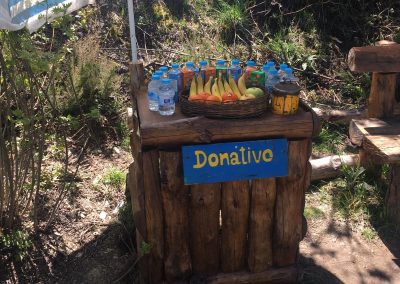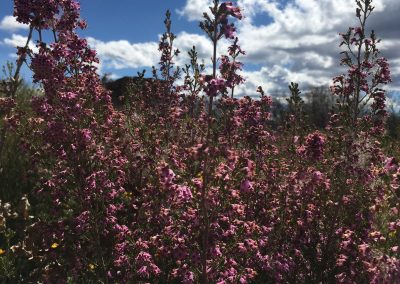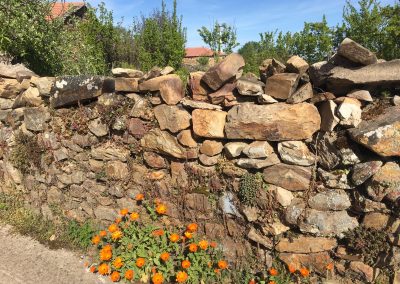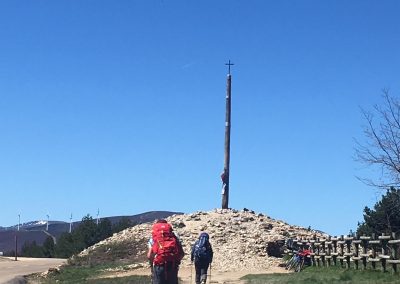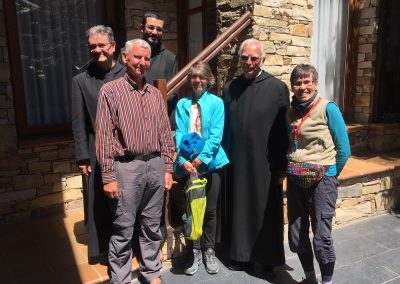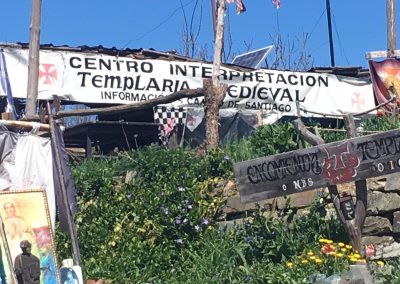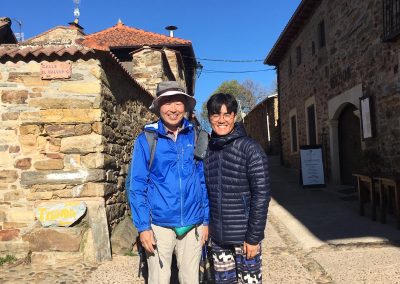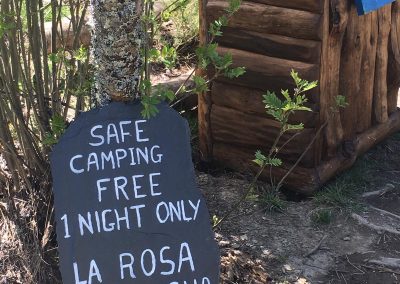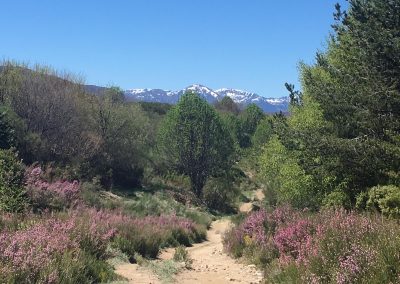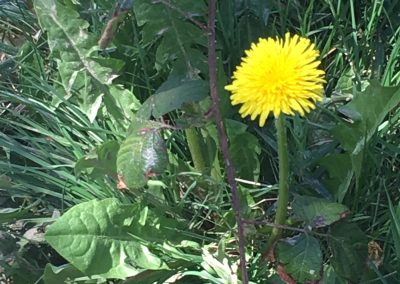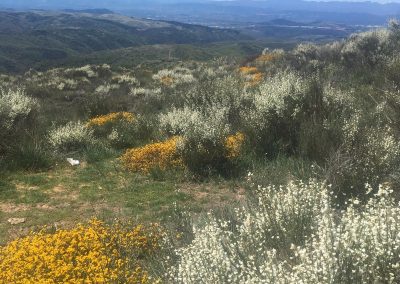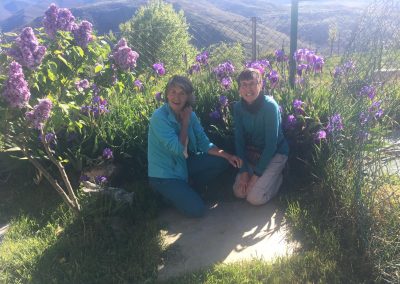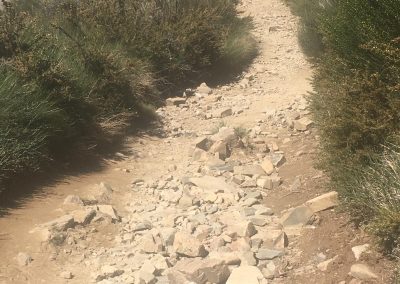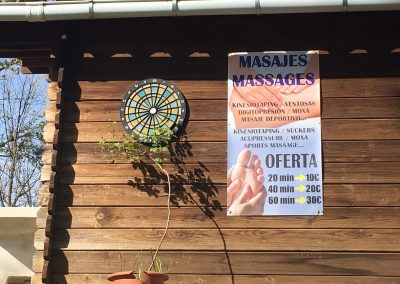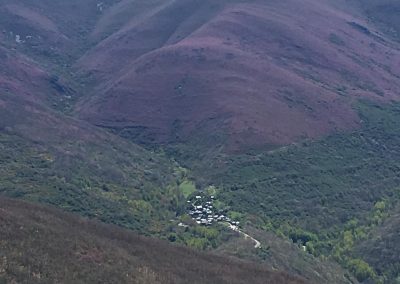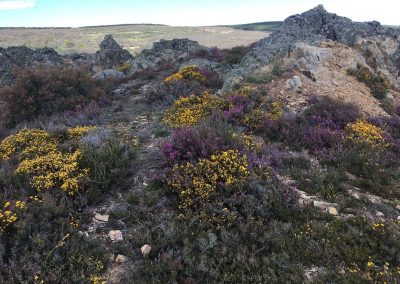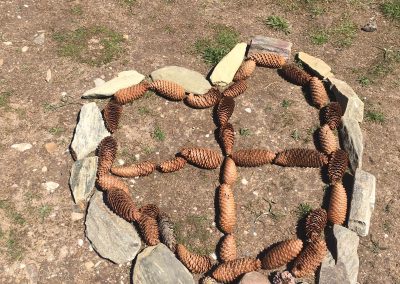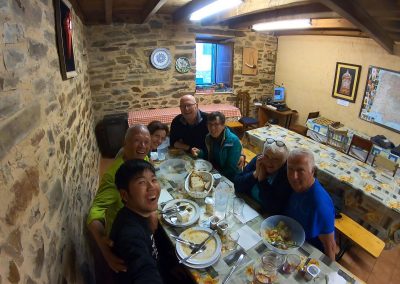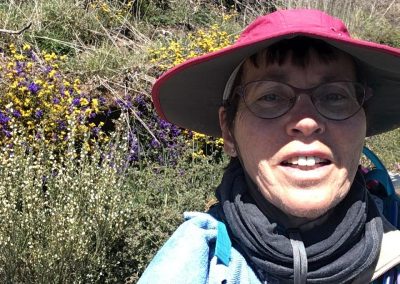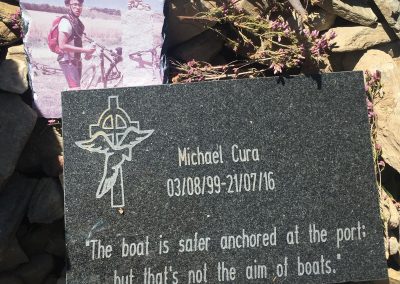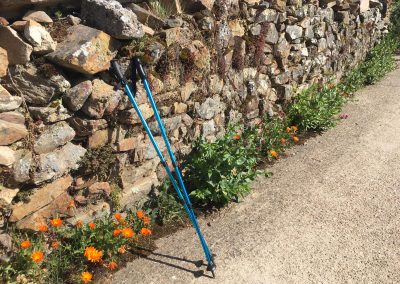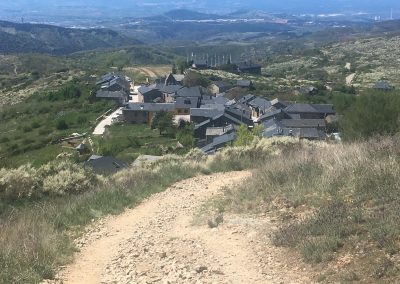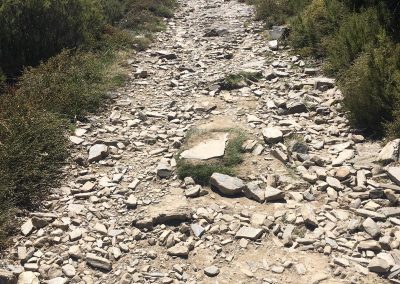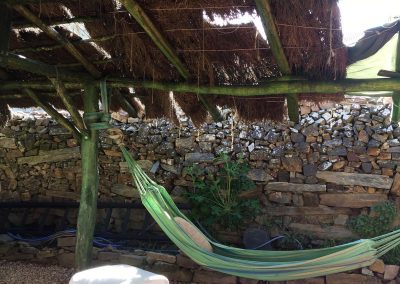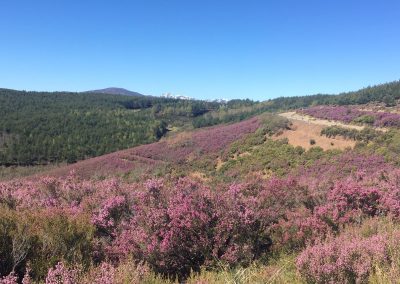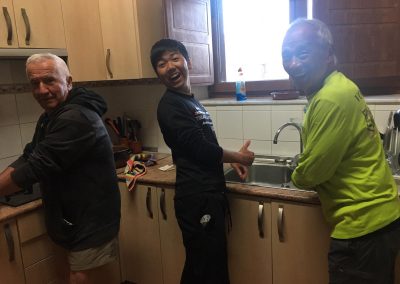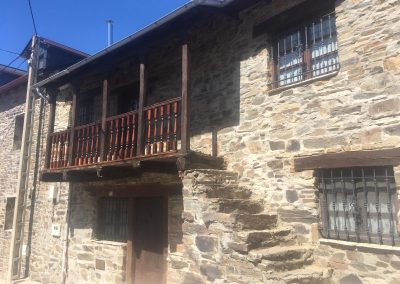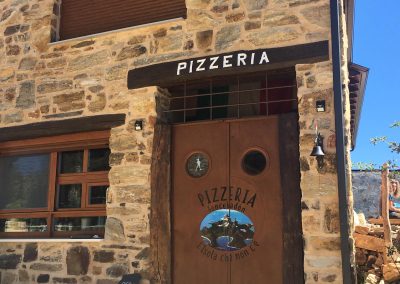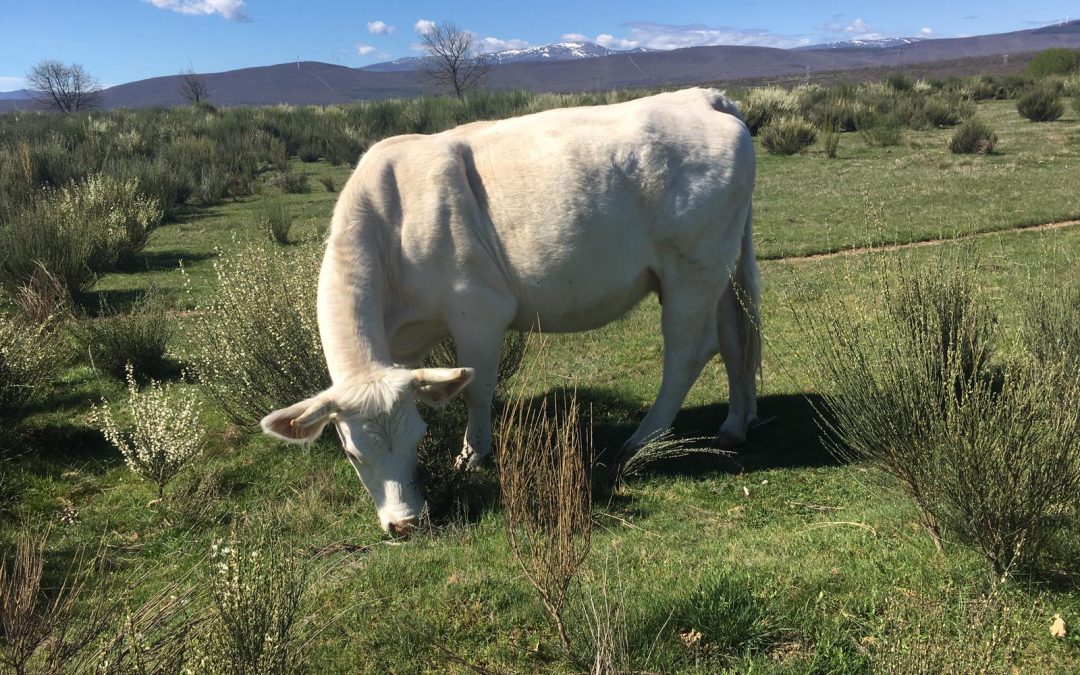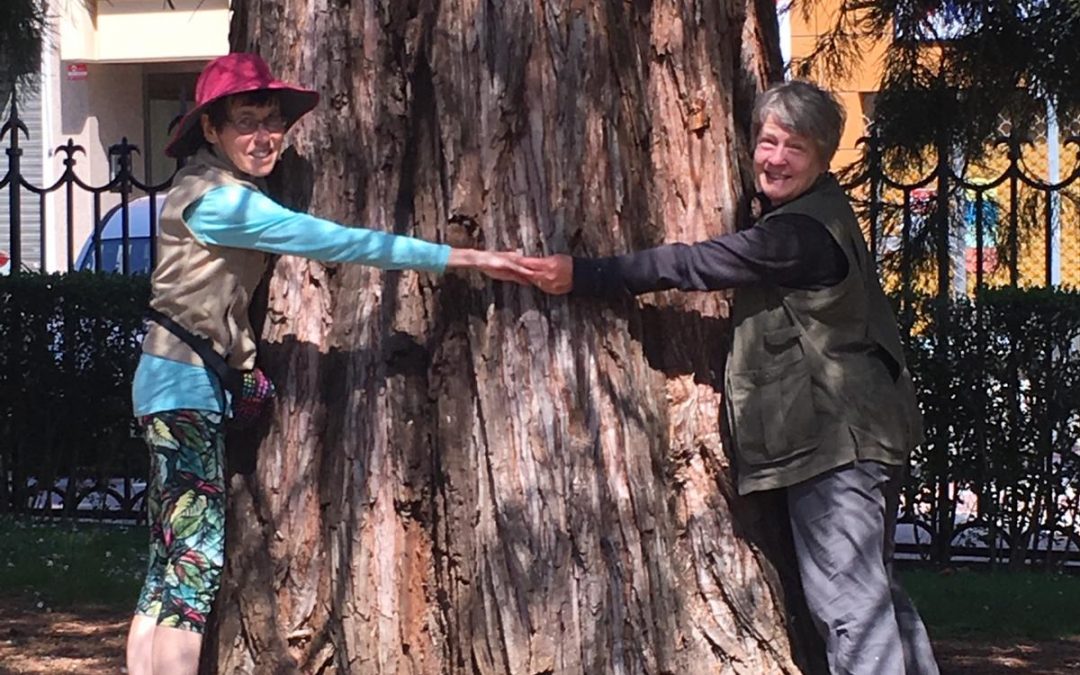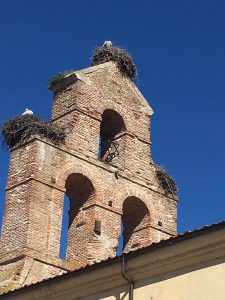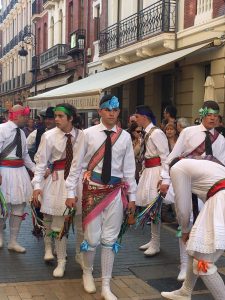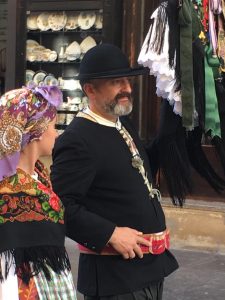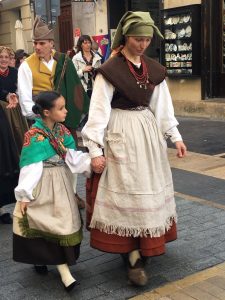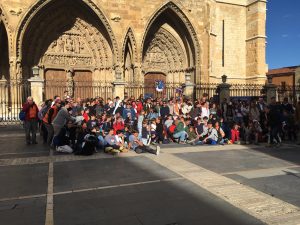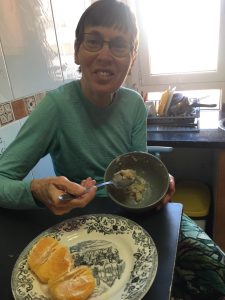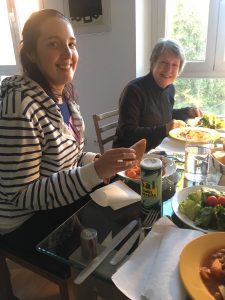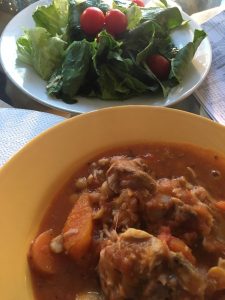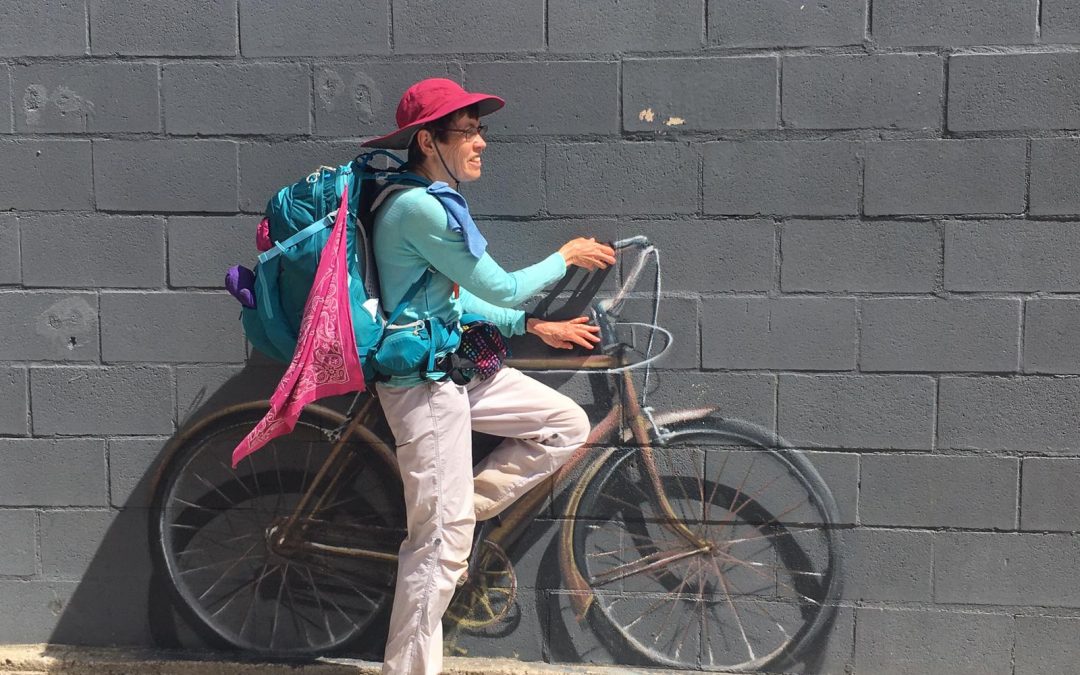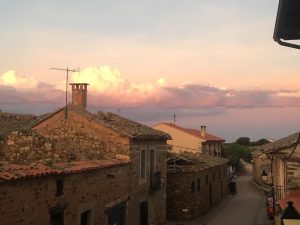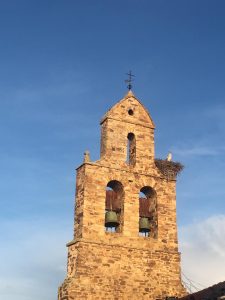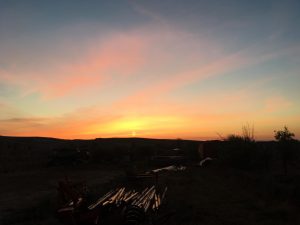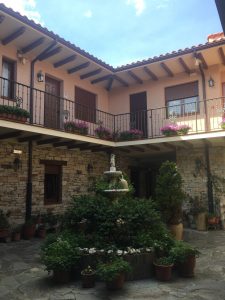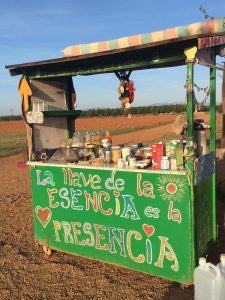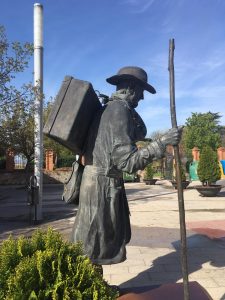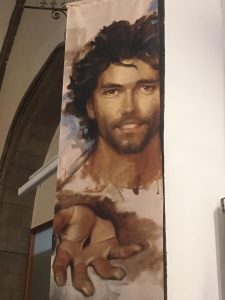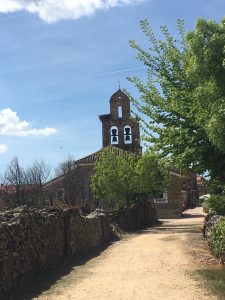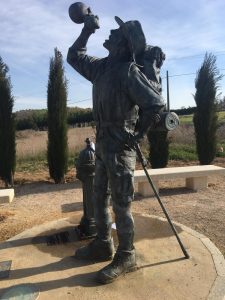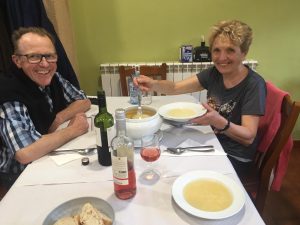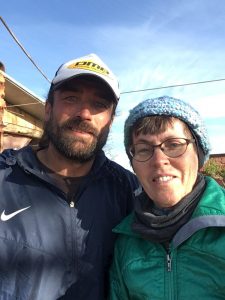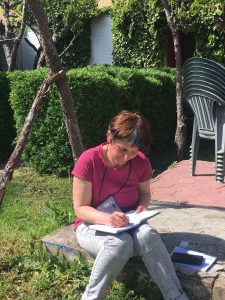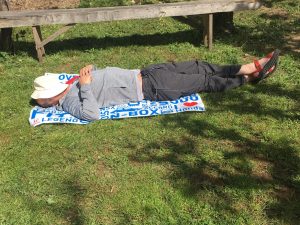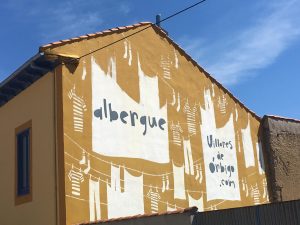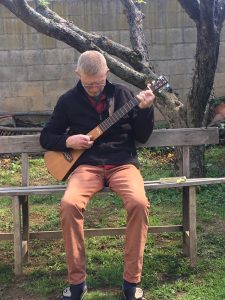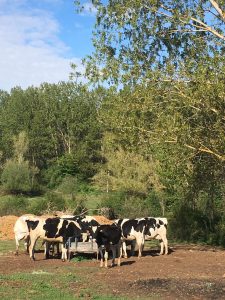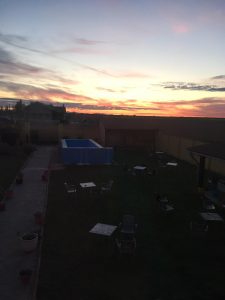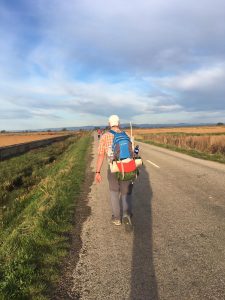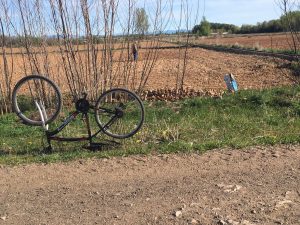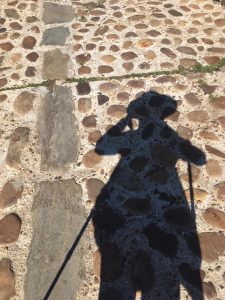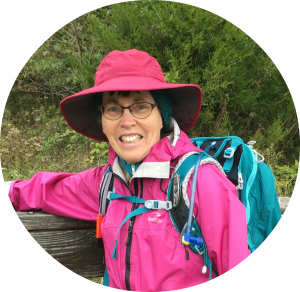Day 25, Tuesday, May 1: Santa Catalina de Somoza to Rabanal del Camino ( 11.5 km, 7.1 miles)
I am, of course, making fun of myself. Four hours to do 7 miles? (A snail… or a “caterpillar train” could probably manage that!) But what a four-hours these were! I think I am beginning to catch on to this “slow down, you’re moving too fast” business. (Another one of the Camino life-lessons that I’m worried will disappear when I return. How to “make the morning last”; how to skip down the literal or figurative cobblestones; how to feel “groovy” more often?…)
Hard to come up with the definitive title for this post. Others that came to me, and in this order (the first five being addressed to the determined cuckoo bird):
- “You are so wrong! So very wrong!”
- “You don’t know what you’re talking about!”
- “You’re full of it!”
- “That’s enough now!”
- “Go fly a kite!”
- “Stop, look, and listen” isn’t just for crossing railroad tracks….
But the morning itself began several hours before such thoughts entered my mind. In spite of not turning off the light until 1:45 am, I woke before my alarm and didn’t have the heart to try to go back to sleep. For one thing, I didn’t know what time I had to leave my private room in the albergue; for another: I didn’t want to miss out on anything, including what kind of a sunrise I might catch from my balcony window. Starting, then, almost an hour before sunrise, I must have taken about a dozen photos of the dawn and the about-to-arrive day, stepping out, stocking-footed, onto my balcony every little bit. The first pilgrim I saw heading off from Santa Catalina departed at 6:30 (45 minutes before sunrise). Let them get on down the road; more pristine solitude for me when I eventually commence my day’s journey.
As I got down to the albergue‘s bar it occurred to me that I hadn’t a clue where I’d left my poles upon my late afternoon arrival. The “poles barrel” was just about empty and my teal poles weren’t in it. I returned to my room, but with little confidence they would be up there. They weren’t. So… I went to check out the first hostel that had delivered the news of “no room in the inn,” the one where the Korean delegation was staying. And indeed, there they (the Koreans) were in front of their albergue, getting some last-minute instructions from their leader. I got waves from some with whom I had had brief conversations or with whom “I had slept” days earlier, then made my way to the entrance of the albergue where, as it happened, my poles were leaning against the door, ready to steady my upcoming walk. (That means that so-far, to my knowledge, I have only lost one disposable paper washcloth that hadn’t totally lived out its usefulness and four or five plastic clothespins which remained behind early in this pilgrimage.)
Back to my albergue where this non-coffee drinker ordered her now near-daily cappuccino. There was a young woman on a stool drinking her own daily jump-start. “Care to join me for a mantecada [special pastry of the region]?” I queried. I had purchased a 6-pack of them in Astorga the previous afternoon and, lightweight as they were, I wasn’t eager to tote them all with me. “A what?” I explained, showing her my package. “Oh…, let me finish with my email and I’ll join you.” She had already walked to Santa Catalina from the prior town, and I think this bit of breakfast suited her. She was soon on her way (and her story, other than her being German and having learned very good English in school, was soon forgotten; hate to say it, but after a while these stories do blend together, especially when the encounters are brief; still, they leave me with a sense of “community”…) and I left not long behind her, just long enough so that… ah, the trail was mine!
The path was at times two-track, at times a single track, following along a barely-used paved road, a buffer of vegetation mostly blocking the sight of said road on my left. The occasional bike or group of cyclists buzzed by, some on the pavement, some on the trail, but otherwise I was alone.
Inspirations came quick and fast, and I spent a lot of time with my face in my phone, taking notes so I could hold on to the thoughts.
They were thoughts about gratitude. About joy. About how absolutely lucky I am to be where I am! At about that point, I saw a “life lesson” painted along a fence:
El secreto de tu futuro está dentro de la rutina diaria. The secret of your future is [found] within the everyday routines [of life].
Oh… so the joy and gratitude and sense of good fortune must be found in, among other things, the cleaning of the kitchen, the folding of laundry, paying the bills…. In this day and age, keeping up with emails and other forms of correspondence…. The secret to finding the future you hope for is finding it right now in the activities you pursue and in the attitude with which you pursue them….
Shoot, we all know that, don’t we? But remembering it and calling upon that secret every day? Can be challenging, to say the least.
Duck, duck, goose!
On I go, thinking, taking notes, being in awe of my surroundings, thoughts giving way to spontaneous song. I come up with “new and possibly improved variations on my “grace, grace, give us grace” song. “Hope” and “peace” and “for you love us all” remain, but “grace” sometimes turns to “trust” or “strength” or courage” or “joy”… or all of the aforementioned. And then one:
Joy, joy, give us joy
Joy to live the life we have chosen. [or sometimes this: …to live the life we’ve been given, for some aspects are our lives are one, and some are the other, right?]
[and then, the familiar coda:]
Give us hope, and give us peace
For you love us all
Then another song from long ago in my past came ‘a haunting me, and I began digging into my memory bank, like an archaeologist slowly uncovering the words. It must have been the focus on “joy” that got me started. Eventually, this is what I pieced together. You may recall it from the 60s:
No man is an island
No man stands alone
Each man’s joy is joy to me
Each man’s grief is my own
We need one another
So I shall defend
Each man as my brother
Each man as my friend
The last of the words was just being uncovered when, upon entering the first little village, El Ganso (and a bit more about it in a few minutes), I hear a rather panicked voice call out something. Was it “¡ay!”? Or was it “¡cuidado!”? I couldn’t say for sure, but it got my immediate attention!
Fortunately! For when I looked up, I saw that I was about to plough right into a car. A parked one, but still….
The voice had come from a nearby open window. I exclaimed to the woman I saw standing there, her hand still up at her mouth, as if still stunned by the sight she had seen. “Oh, señora, ¡un millón de gracias! ¡Me ha salvado la vida!” A slight exaggeration, yes; I don’t think my life would have come to a dead halt on the hood of that vehicle, but… golly, hadn’t the woman come upon the scene just in time to be of service? (Wasn’t I just singing about how “we need one another”? Wasn’t she “defending a friend” just as in the song’s lyrics? Coincidence? Serendipity? At the least, her being “in the right place at the right time.”
My rescuer motioned behind her and immediately another woman then showed up at the open window. Fair-skinned, blond, maybe 50-something. Was this an albergue of some type? The newly-arrived woman looked like I did the first ten days or so on the Camino: she had a black eye. “¿Te has caído?” I ask, commiserating. “No, no,” answers the first woman. “Le han pegado” [She’s been beaten]. No habla nada de español. Es alemana.” So… the German woman has sustained injuries to her face and her arm, and… she has taken refuge in the soon-to-be-described village of El Ganso (translation: The Goose!). An older gentleman–obviously not the perpetrator of the abuse–appears at her side. All three smile. “May I take a picture of the three of you?” I venture. “I’d like a visual reminder of the accident I almost had and of the people who witnessed the near-accident and saved me from it.” (Ok, so those weren’t the exact words, but close!). The Spanish woman is a bit resistant. Her hands fly to her hair, she gestures to the nightclothes she is still wearing and brings up the fact that she has just awakened (in time, note, to “save” me), but then she consents.
This was my “welcome” to El Ganso, population too small to be noted in my guidebook, but about which said book has this to say:
a hauntingly crumbling village, evoking a sense of loss or, perhaps, a reminder of a less hurried time. In the 12th century it boasted a monastery and a pilgrim hospital. El Ganso is the first of several Maragato–[my clarification: like one of our “counties” in the US perhaps]–villages that we pass through in the relatively solitary mountains…. If the opportunity arises to meet the locals, don’t pass it by!
Perhaps I don’t have the actual situation totally correct. For me? For me, in this crumbling near-deserted town, a resident has figured out a way to give refuge to abused women whose language she doesn’t understand but who has perhaps once found herself in a similar situation. Perhaps…. “Blessed be the merciful for they shall find mercy.”
Three more things of note in this “crumbling village”:
- There is a bar in town. It is called–and decorated, after a fashion, in accord with its name–Cowboy Bar. As I’m passing by the outdoor patio I see a woman with her head down on the table. “Is she alright?” I call out as softly as possible to a man at the only other table. Having witnessed what I interpreted as a work of mercy, I wondered what I might have in my pack to bring some comfort to a weary pilgrim (or to one who was stoned? What did I know?) The woman raised her head at my query and said she was fine. I’m off.
- Just across the narrow street from the Cowboy Bar, I stop to read a large sign. It said, basically, in several languages–you’ll understand in a minute why I didn’t take a photo to preserve the exact words for posterity–“please be respectful of me and my desire to live my life my way and do not take photographs of me or my abode.” As I continued, the sounds of (East Indian) music and the smell of incense met me, and I spotted a tanned man whom I cannot describe in any more detail because, wanting to respect his right to privacy there on the side of the village’s one and only–I think–street, I did not take a long look. I continued on.
- As I stopped to look at the village church–checking to see if the storks, like the people, had abandoned this hamlet–and, indeed, they appeared to have done so, the sole nest in the bell tower being empty–the French couple with whom I had dined last night walked up. As often happens, we took turns taking photos of one another in front of the church. We had a bit of back-and-forth chatting about how pleasant it had been to dine together and about how, with gestures and some inadequate language skills, we had managed to laugh and entertain ourselves. I sent them on ahead so that they could enjoy having the trail “to themselves” and so that, a few minutes later, I could do the same.
Good-bye, El Ganso. I couldn’t have asked any more from you that what you offered. Much appreciated!
Up to this point, I have traveled only 4 kilometers. 2.5 miles when rounded up! I continue.
From strangers to friends, if only for a short time
I continue my thinking and my singing as I approach Rabanal del Camino where I plan to spend several days “in silent retreat” at the albergue provided by the Benedictine Monastery of San Salvador del Monte Irago. My intention had been to arrive early to assure that I got one of their ten beds. That resolution seemed to fall by the wayside as I accepted the “offerings” of the day. Before I reached the monastery, I was to have two more somewhat lengthy encounters.
The first was at a … how do I explain this? A “roadside stand”? An “open-air way stop”? A “castle out-post”? A ….? I don’t have the right word or name, so I’ll just continue with a description of what/who I came upon. Read on.
I cross a road and see, on a bit of a slope just adjacent to the trail, a canopied table at which was sitting… a… “knight”? A person dressed in attire from… 12th century? 13th? 14th? (A historian I am not). I hope you will find somewhere on this post the only photo I got of this person whose name I failed to get but whose story intrigued me. So there he sits, not in armor, mind you, but in chainmail (right word, I hope; I have no internet access at the moment to double check any vocabulary, not that I would bother even if I did..), the chainmail covering his head and his chest. The when-not-in-wartime attire, perhaps. In front of him on the table, a quill pen standing in an ink-filled pot. Also, upon further investigation, a small sign, in six languages, poses this question: “Would you like to see the most beautiful thing in the world?” The sign was in front of a small wooden box. (You can guess, can’t you? I did. Upon opening it, of course, I saw myself.)
The “knight”–that’s how I’ll continue to refer to him–was there to put sellos [stamps] in pilgrim’s credenciales and enter the date of the encounter with his plume. But more than anything, he was there on behalf of the Asociación Gaudisse (Gaudisse Association), a group dedicated to raising funds and providing support for children hospitalized with cancer or other serious illnesses, as well as to creating activities to increase social interaction for children and youth with disabilities of any sort. Next to the table was a very large poster with photos of some of the interactions brought about by the efforts of this association. One of the photos in the collage showed a bald-headed adult (maybe 50) with a similarly bald-headed child. The former was the knight with whom I was speaking. This I only learned after we had been talking for a while.
He tells me first about some of the things the group does with the children. “We visit with them in the hospital. We go wherever they are. We let them dress like princesses and knights. We have celebrations with them. Show them a fun time.”
He wasn’t going to go into his story. “It is a long one. Complicated.” I told him I had time.
And so, he began to give it to me. 18 years ago this knight was diagnosed with brain cancer. Not good. Reality hit. His daughter was 6 years old at the time. He took her on a camping trip. They were out under the stars where he planned to ease her gently into news of his illness, to somehow prepare her for the worst. He began with a round-about explanation of the stars they were seeing above their heads. Talking about infinity and eternity (to the extent possible when talking with a six-year-old). He eventually looked down at his daughter and realized that she was fast asleep. Seeing that he had not been able to deliver his “farewell” to her, it came to him that this was not his time to go, that he would live to raise her. And so he did.
Ten years later, he was diagnosed again with brain cancer, this time a more serious form: glio-blastoma multiforma (sp?). Not good. But here he is, telling me his story ten years later! He is now retired, doing what he can to help children and to give them joy and hope. Because… (my thoughts here–or Dunne’s words, if you will… but the themes keep repeating, don’t they?) “no man is an island, no man stands alone….”
The knight was diagnosed with another cancer three years ago. Stomach area. But nonetheless he comes out to greet the pilgrims along the trail, wish them well, stamp their passports, explain his purpose, and hope that some will leave a contribution for the Gaudisse Association.
The card he gave me has many online links. One of the following links might prove useful if you are moved to investigate further:
- Www.canalperegrino.com
- Facebook.com/asociaciongaudisse
- Facebook.com/miradordegaudisse
- Facebook.com/yennevacasas
- [email protected]
He also said that if anyone wanted to communicate with him directly about his illness and his to-date recovery, he would be happy to correspond with such a person through Facebook. (Unfortunately, I’m not sure which of the above Facebook addresses would belong to him.)
I told the knight of my good friend with glio-blastoma, and said I thought that my encounter with him was meant to be. So that I could pass on his story to her. He shared with me the five things to which he attributes his cure. I pass them along because, really, they are five things that we all might do in daily life, all within our reach if we so choose. I present them below, translated from Spanish in the order in which he gave them to me, though he would want you to know, they are not necessarily in the order of importance:
- Do whatever it takes to eliminate stress
- Eat the best food possible, regardless of the expense
- Participate in sports or at least in daily exercise
- Maintain a positive attitude
- Do what you can to help others, and if you can’t help, at least do no harm
Not revolutionary. Nothing we haven’t heard. My knight was an example of putting these principles to the test and coming out a winner. I recognize this: he has also been very lucky. Whatever it takes….
I’m about 6 kilometers down the road. My notes remind me of some other aspects or thoughts or songs of the day up until this point:
- Upon leaving Santa Catalina earlier, I had sung: “Oh what a beautiful morning…” and smiled to myself when I got to these words: “everything’s going MY WAY“! [Note: a frequent translation of “Camino” is “way”]
- It came to me: perhaps I had learned Spanish all those many years ago precisely so that I could have the experiences that I am having on the Camino. I remind myself of what a gift it was that Dad said “yes” back at Christmastime in 1966 when I presented the idea–actually, it was my sister Marie who first broached the subject with him because I was too afraid to even bring it up…–the idea of my spending 7 weeks studying and touring in Spain, at age 17
- I recall the words of St. Francis of Assisi–hope it indeed was him; at any rate, it was some important saint–“Preach always. And, if you must, use words.” (Forgive me, Francis, for being so loquacious; I can’t seem to help myself). Why do I think of him today? Because the good saint is said to have trod these very paths back in the 1200s, and to have stayed in some of the same villages where i am staying. Very likely to have prayed in some of the same churches in which I have been praying
- Boy, the Spirit is really talking to me today!
- Was doña María wrong when she chided, weeks ago, to me: “The Camino isn’t a Camino of roses. It is a Camino of thorns.” Thorns? To me it has become a Camino of gifts
- And so on. “…and, if necessary, use words.” …
One more encounter along today’s walk that I feel called to share. Another friend I’ll likely never see again. You’re about to meet Ben from England.
So I finally enter Rabanal. I’ll be looking for the monastery. But I see a young man–25? 30? Everyone under 50 looks young to me anymore..–sitting near a stone building just along the principal street of town. On a turned-on-its-side box he has written: “Is it time to CHANGE YOUR WAY?”[Yes, remember, “camino” = “way”.] And in smaller print, he explains: “I have walked more than 9000 kilometers on the Camino. Each day I write. Here are some of my reflections of things I have learned. Please take one” On the top ledge of the box, under a stone serving as a paperweight, were perhaps 15 or 20 slips of paper. After a bit of chatting with their creator, I chose one. “I’ll read it aloud,” I said to Ben, “and then maybe we can talk about it.” It read as follows:
A lingering sadness in life will keep on reoccurring until the sensation it is expressing within is listened to & understood. When its deep-lying message is heard one can file it away under acceptance & move on with renewed strength & purpose in life.
Listen. Reflect. Understand. Accept. [Change?] Move on. Purpose.
Bless this young fellow! Exotic but sincere. Moving through life, making his way from village to village sharing messages of hope. Another young man did that some two thousand years ago and we’re still trying to ponder, interpret, evaluate, absorb, and possibly follow his messages….
Ben sat there as we chatted, cutting more strips of paper, more reflections to share. “Are each and every one of them unique?” I asked him. I was assured that there were some repeats, repeats of the most important ones. My eyes lingered on the messages still under the rock. A part of me wanted to choose a few more, greedy that I am for words and (possible) wisdom (believe it or not: I do not ascribe to everything I see or hear!). “Do you have an online presence? A place where you store your reflections for the benefit of others?” Ben told me he had a blog, though not necessarily a collection of the thoughts he offered at the roadside. In somewhat of an imitation of the Russian author he so admires, he has called his blog “homelessness and punishment.” I haven’t had the chance to check it out, but if you are interested, the full link is as follows: homelessnessandpunishment.home.com
Buen Camino. Buena vida, Ben!
HOME SWEET HOME
Speaking of home, I soon reached what was to be mine for the next two or three evenings (TBD). I was warmly received by Father Javier who had just begun to give a tour of the facilities to a pilgrim from Korea who had arrived only minutes earlier.
I have reached my journey’s end for the day, at least the walking part of the journey. The monastery experience deserves its own post once my stay here is complete. And so, more to follow somewhere further along THE WAY.
Thanks for walking with me!
